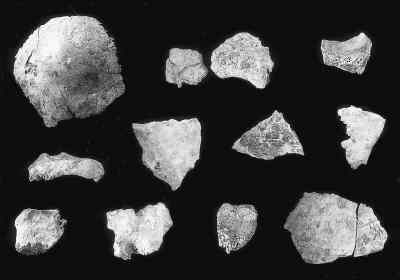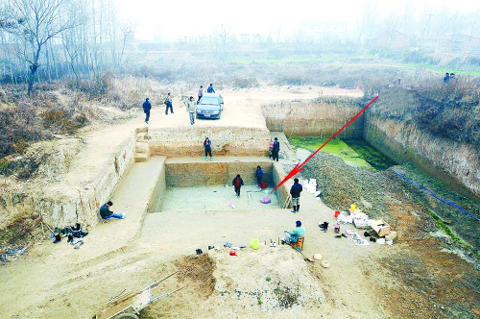Posted on 01/23/2008 11:48:22 AM PST by SunkenCiv
An almost complete human skull fossil that could date back 100,000 years was unearthed in Henan last month, Chinese archaeologists announced yesterday... The Henan find was made after two years of excavation at the site in Xuchang. Archaeologists have worked on an area of 260 sq m, merely one-hundredth of the Paleolithic site... The fossil consisted of 16 pieces of the skull with protruding eyebrows and a small forehead. More astonishing than the completeness of the skull is that it still has a fossilized membrane on the inner side, so scientists can track the nerves of the Paleolithic ancestors... The pieces were fossilized because they were buried 5 m near the mouth of a spring, whose water had a high content of calcium. Besides the skull, more than 30,000 animal fossils, and stone and bone artifacts were found in the small area in the past two years. The pieces of the human skull showed up just when archaeologists were going home for the Spring Festival... The Paleolithic site was discovered in 1965, when IVPP scientists found animal fossils and stone artifacts from soil dug for a well. Excavation started in June 2005.
(Excerpt) Read more at china.org.cn ...
|
|
|||
Gods |
To all -- please ping me to other topics which are appropriate for the GGG list. |
||
|
· Mirabilis · Texas AM Anthropology News · Yahoo Anthro & Archaeo · · History or Science & Nature Podcasts · Excerpt, or Link only? · cgk's list of ping lists · |
|||
Nerves in the dura mater?
Looks like a cabbage leaf to me. :’)

Seated in the front row of a White House Presser.
Those are blood vessels, branches of the middle meningeal artery. The dura does have nerves, too which are branches of the trigeminal nerve.
At first glance I thought that they had opened up Robert Byrd’s head.

Besides the skull, more than 30,000 animal fossils, and stone and bone artifacts were found in the small area in the past two years.
That's an awful lot of animal fossils in a 'small area' but no mention of species?
Is the age of the skull based on 'protruding eyebrows and a small forehead'?
'Stone and bone artifacts' hmmm...Hey China, show me!
Jonathan Watts in Beijing
Wednesday January 23, 2008
Guardian Unlimited (UK)

Some of the pieces of the ancient human skull unearthed in central China’s Henan province. Photograph: China Daily/Reuters
Chinese archaeologists are hailing their biggest discovery in the country for almost 80 years after unearthing an ancient skull that could provide a clue about the origins of a fifth of the world's population.
The fossilised skull - named Xuchang Man after its location - is thought to date back 80,000 to 100,000 years, a period that has long been a mystery to scientists.
It contains a rare fossilised membrane that archaeologists hope will reveal important details about the nervous system of people from the era and settle a contentious academic debate about whether the majority of China's 1.3bn population are mainly indigenous, descended from African migrants or intermixed.
The almost complete skull, which comprises of 16 fragments, was found in the central province of Henan last month. It has protruding eyebrows and a small forehead. Government officials said the find was second in importance only to that of Peking Man in 1929, when archeologists discovered five almost complete skulls and other bones believed to date back 250,000 to 500,000 years.
"It is the greatest discovery in China after the Peking Man and Upper Cave Man skull fossils were found in Beijing early last century, and will shed light on a critical period of human evolution," Shan Jixiang, director of the State Administration of Cultural Heritage was quoted as saying by the Xinhua news agency.
The Xuchang site had been of interest since the mid 1960s when villagers found ancient tools while they were digging a well. But it was only two years ago, after the spring dried up, that the Henan cultural relics and archaeology research institute began excavating the area.
The 17-member team has also found thousands of animal fossils and other artefacts.
The skull was unearthed in freezing conditions just as the last two archaeologists on the site were closing down the dig ahead of the upcoming lunar new year holiday. The framents were found at five metres depth near the calcified mouth of the spring.
"When we started digging on this site, we expected to find something important, but not this important," Li Zhanyang, who led the excavation, told the Guardian. "When we discovered the skull we couldn't believe it. We were thrilled, but we also felt a lot of pressure."
Although not as old as other discoveries, he said the skull could fill a huge gap in our knowledge of human evolution.
Most palaeoanthropologists believe all modern homo sapiens are descended primarily from people who came out of Africa about 60,000 years ago. Another view is that there was significant interbreeding in Europe and elsewhere with Neanderthals. Some Chinese scientists make a stronger link with Peking man, saying there is more regional continuity than western scientists believe.
The skull fragments are now at the China Academy Of Sciences in Beijing, where they will be reconstructed and analysed. If there is any residual organic material, DNA analysis may be possible. Foreign scientists say the potential of the find is enormous.
"This is a crucial period in human evolutionary history, but we know almost nothing about it. Anything coming from that period of great interest to outside world," said Dennis Etler, a palaeoanthropologist at Cabrillo College in California. "This sounds like a breakthrough."
Li and his team hope to excavate further at the site in the hope of finding evidence of how ancient Asians used fire and built dwellings. They have found fragments of charred animals bones, which has led them to believe that China's ancestors cooked meat at an early stage.
The controversy about the origins of today's Chinese people may not be cleared up completely however. Comparisons with the nation's oldest dwellers will be hampered by the disappearance of the skulls of Peking Man, which went missing in mysterious circumstances in 1941.
In case there was any foul play involved, can you tell me where you were on that Thursday night, 98,000 BC?


And one day someone will dig up this Melanesian's skull and try to tell us it is 100,000 years old...
The article didn't state what the man supposedly was (homo erectus or sapiens).
A little. But these look legit. The only real question will become, is the dating correct?
Hey, I was out of town when that happened. Way out of town. So far out of town, the town wasn’t even there yet. That’s how way out.
I told those kids to play frisbee somewhere else.
I told those kids to play frisbee somewhere else.
Probably his older brother. No brains were found.
Disclaimer: Opinions posted on Free Republic are those of the individual posters and do not necessarily represent the opinion of Free Republic or its management. All materials posted herein are protected by copyright law and the exemption for fair use of copyrighted works.